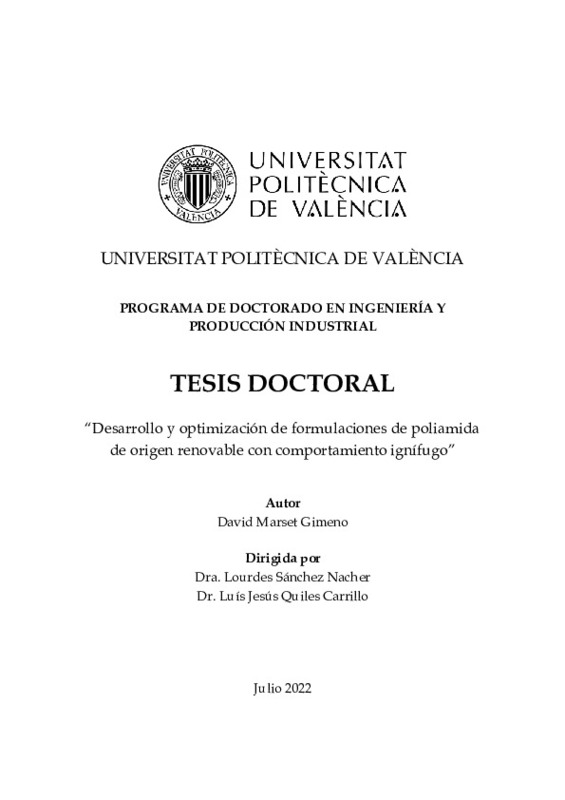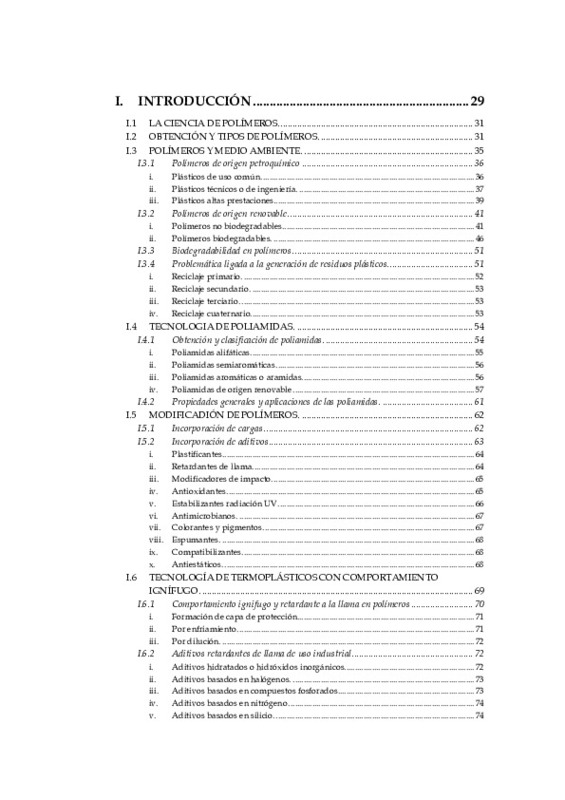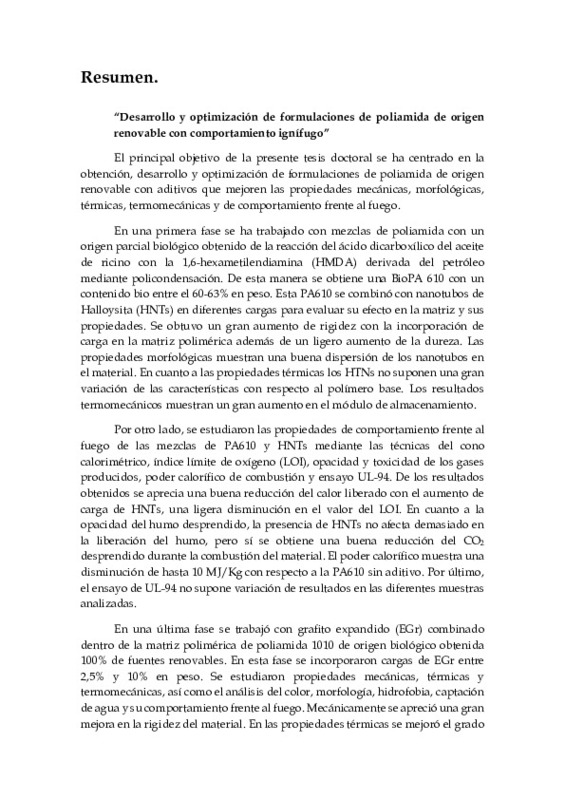- RiuNet repositorio UPV
- :
- Investigación
- :
- Tesis doctorales
- :
- Ver ítem
JavaScript is disabled for your browser. Some features of this site may not work without it.
Buscar en RiuNet
Listar
Mi cuenta
Estadísticas
Ayuda RiuNet
Admin. UPV
Desarrollo y optimización de formulaciones de poliamida de origen renovable con comportamiento ignífugo
Mostrar el registro sencillo del ítem
Ficheros en el ítem
| dc.contributor.advisor | Quiles Carrillo, Luis Jesús
|
es_ES |
| dc.contributor.advisor | Sánchez Nacher, Lourdes
|
es_ES |
| dc.contributor.author | Marset Gimeno, David
|
es_ES |
| dc.date.accessioned | 2022-09-02T12:09:35Z | |
| dc.date.available | 2022-09-02T12:09:35Z | |
| dc.date.created | 2022-07-08 | |
| dc.date.issued | 2022-09-02 | es_ES |
| dc.identifier.uri | http://hdl.handle.net/10251/185134 | |
| dc.description | Tesis por compendio | es_ES |
| dc.description.abstract | [ES] El principal objetivo de la presente tesis doctoral se ha centrado en la obtención, desarrollo y optimización de formulaciones de poliamida de origen renovable con aditivos que mejoren las propiedades mecánicas, morfológicas, térmicas, termomecánicas y de comportamiento frente al fuego. En una primera fase se ha trabajado con mezclas de poliamida con un origen parcial biológico obtenido de la reacción del ácido dicarboxílico del aceite de ricino con la 1,6-hexametilendiamina (HMDA) derivada del petróleo mediante policondensación. De esta manera se obtiene una BioPA 610 con un contenido bio entre el 60-63% en peso. Esta PA610 se combinó con nanotubos de Halloysita (HNTs) en diferentes cargas para evaluar su efecto en la matriz y sus propiedades. Se obtuvo un gran aumento de rigidez con la incorporación de carga en la matriz polimérica además de un ligero aumento de la dureza. Las propiedades morfológicas muestran una buena dispersión de los nanotubos en el material. En cuanto a las propiedades térmicas los HTNs no suponen una gran variación de las características con respecto al polímero base. Los resultados termomecánicos muestran un gran aumento en el módulo de almacenamiento. Por otro lado, se estudiaron las propiedades de comportamiento frente al fuego de las mezclas de PA610 y HNTs mediante las técnicas del cono calorimétrico, índice límite de oxígeno (LOI), opacidad y toxicidad de los gases producidos, poder calorífico de combustión y ensayo UL-94. De los resultados obtenidos se aprecia una buena reducción del calor liberado con el aumento de carga de HNTs, una ligera disminución en el valor del LOI. En cuanto a la opacidad del humo desprendido, la presencia de HNTs no afecta demasiado en la liberación del humo, pero sí se obtiene una buena reducción del CO2 desprendido durante la combustión del material. El poder calorífico muestra una disminución de hasta 10 MJ/Kg con respecto a la PA610 sin aditivo. Por último, el ensayo de UL-94 no supone variación de resultados en las diferentes muestras analizadas. En una última fase se trabajó con grafito expandido (EGr) combinado dentro de la matriz polimérica de poliamida 1010 de origen biológico obtenida 100% de fuentes renovables. En esta fase se incorporaron cargas de EGr entre 2,5% y 10% en peso. Se estudiaron propiedades mecánicas, térmicas y termomecánicas, así como el análisis del color, morfología, hidrofobia, captación de agua y su comportamiento frente al fuego. Mecánicamente se apreció una gran mejora en la rigidez del material. En las propiedades térmicas se mejoró el grado de cristalinidad del material. El análisis termomecánico mostró un aumento en el módulo (E) y en el módulo de almacenamiento (E'). El estudio de la hidrofobia y la captación de agua dio como resultado una reducción en la absorción de agua y un aumento de la hidrofobicidad del material. Por último, en cuanto a las propiedades del material frente al fuego, se consiguió reducir en gran medida la liberación de calor emitido. El valor del índice límite de oxígeno se reduce ligeramente y el ensayo de la UL-94 muestra una mejora de V-2 a V-1 en la clasificación del compuesto con la incorporación de EGr frente al polímero sin aditivar. | es_ES |
| dc.description.abstract | [CA] El principal objectiu de la present tesi doctoral s'ha centrat en l'obtenció, el desenvolupament i l'optimització de formulacions de poliamida d'origen renovable amb additius que millorin les propietats mecàniques, morfològiques, tèrmiques, termomecàniques i de comportament davant del foc. En una primera fase s'ha treballat amb barreges de poliamida amb un origen parcial biològic obtingut de la reacció de l'àcid dicarboxílic de l'oli de ricí amb la 1,6-hexametilendiamina (HMDA) derivada del petroli mitjançant policondensació. D¿aquesta manera s'obté una BioPA 610 amb un contingut bio entre el 60-63% en pes. Aquesta PA610 es va combinar amb nanotubs de Halloysita (HNTs) en diferents càrregues per avaluar el seu efecte a la matriu i les seues propietats. Es va obtenir un gran augment de rigidesa amb la incorporació de càrrega a la matriu polimèrica a més d'un lleuger augment de la duresa. Les propietats morfològiques mostren una bona dispersió dels nanotubs al material. Quant a les propietats tèrmiques, els HTNs no suposen una gran variació de les característiques respecte al polímer base. Els resultats termomecànics mostren un gran augment en el mòdul d'emmagatzematge. D'altra banda, es van estudiar les propietats de comportament davant del foc de les barreges de PA610 i HNTs mitjançant les tècniques del con calorimètric, índex límit d'oxigen (LOI), opacitat i toxicitat dels gasos produïts, poder calorífic de combustió i assaig UL-94. Dels resultats obtinguts s'aprecia una bona reducció de la calor alliberada amb l'augment de càrrega de HNTs, una lleugera disminució al valor del LOI. Quant a l'opacitat del fum desprès, la presència de HNTs no afecta gaire en l'alliberament del fum, però sí que s'obté una bona reducció del CO2 desprès durant la combustió del material. El poder calorífic mostra una disminució de fins a 10 MJ/Kg respecte de la PA610 sense additiu. Finalment, l'assaig d'UL-94 no suposa variació de resultats a les diferents mostres analitzades. En una darrera fase es va treballar amb grafit expandit (EGr) combinat dins de la matriu polimèrica de poliamida 1010 d'origen biològic obtinguda 100% de fonts renovables. En aquesta fase es van incorporar càrregues d'EGr entre el 2,5% i el 10% en pes. Es van estudiar propietats mecàniques, tèrmiques i termomecàniques, així com l'anàlisi del color, la morfologia, la hidrofòbia, la captació d'aigua i el seu comportament davant del foc. Mecànicament es va apreciar una gran millora en la rigidesa del material. A les propietats tèrmiques es va millorar el grau de cristal·linitat del material. L'anàlisi termomecànica va mostrar un augment al mòdul (E) i al mòdul d'emmagatzematge (E'). L'estudi de la hidrofòbia i la captació d'aigua va donar com a resultat una reducció de l'absorció d'aigua i un augment de la hidrofobicitat del material. Finalment, quant a les propietats del material davant del foc, es va aconseguir reduir en gran mesura l'alliberament de calor emesa. El valor de l'índex límit d'oxigen es redueix lleugerament i l'assaig de la UL-94 mostra una millora de V-2 a V-1 a la classificació del compost amb la incorporació d'EGr davant del polímer sense additivar. | es_ES |
| dc.description.abstract | [EN] The main objective of this doctoral thesis has focused on obtaining, developing and optimizing polyamide formulations of renewable origin with additives that improve the mechanical, morphological, thermal, thermomechanical and fire behavior properties. In a first phase, has been carried out an experimental with polyamide mixtures with a partial biological origin obtained from the reaction of the dicarboxylic acid of castor oil with 1,6-hexamethylenediamine (HMDA) derived from petroleum by means of polycondensation. In this way, a BioPA 610 with a bio content between 60-63% by weight is obtained. This PA610 was combined with Halloysite nanotubes (HNTs) at different loadings to evaluate its effect on the matrix and its properties. A large increase in stiffness was obtained with the incorporation of filler in the polymeric matrix in addition to a slight increase in hardness. The morphological properties show a good dispersion of the nanotubes in the material. Regarding the thermal properties, the HTNs do not imply a great variation of the characteristics with respect to the base polymer. The thermomechanical results show a large increase in the storage modulus. On the other hand, the fire behavior properties of the mixtures of PA610 and HNTs were studied using the calorimetric cone techniques, limit oxygen index (LOI), opacity and toxicity of the gases produced, calorific value of combustion and UL-94 test. From the results obtained, a good reduction of the heat released with the increase in the load of HNTs, a slight decrease in the value of the LOI, can be seen. Regarding the opacity of the smoke released, the presence of HNTs does not affect the release of smoke too much, but a good reduction of the CO2 released during the combustion of the material is obtained. The calorific power shows a decrease of up to 10 MJ/Kg with respect to PA610 without additive. Lastly, the UL-94 test does not assume any variation in results in the different samples analysed. In a final phase, expanded graphite (EGr) combined within the polyamide 1010 polymeric matrix of biological origin obtained 100% from renewable sources was worked on. In this phase, EGr loads between 2.5% and 10% by weight were incorporated. Mechanical, thermal and thermomechanical properties were studied, as well as the analysis of color, morphology, hydrophobicity, water uptake and its behavior against fire. Mechanically, a great improvement in the rigidity of the material was appreciated. In the thermal properties, the degree of crystallinity of the material was improved. The thermomechanical analysis showed an increase in the modulus (E) and in the storage modulus (E'). The study of hydrophobicity and water uptake resulted in a reduction in water absorption and an increase in the hydrophobicity of the material. Finally, regarding the properties of the material against fire, it was possible to greatly reduce the release of emitted heat. The value of the oxygen limit index is slightly reduced and the UL-94 test shows an improvement from V-2 to V-1 in the classification of the compound with the incorporation of EGr compared to the polymer without additives. | es_ES |
| dc.description.sponsorship | This research was funded by the Ministry of Science, Innovation, and Universities (MICIU) project numbers MAT2017-84909-C2-2-R and AGL2015- 63855-C2-1-R. Project funded with grant number PID2020-116496RB-C22 funded by the Ministry of Science and Innovation MCIN/AEI/10.13039/501100011033 and grant number AICO/2021/025 funded by Generalitat Valenciana. AITEX wants to thank CDTI (Centro para el Desarrollo Tecnológico Industrial) within the framework of grants for Technological Centres of Excellence “Cervera” (CER- 20211013). The author would like to thank the INTERREG SUDOE NABITEX project (SOE2/P1/P0524) for allowing him to participate in it as part of his training. | es_ES |
| dc.format.extent | 235 | es_ES |
| dc.language | Español | es_ES |
| dc.publisher | Universitat Politècnica de València | es_ES |
| dc.rights | Reserva de todos los derechos | es_ES |
| dc.subject | Biopolyamide | es_ES |
| dc.subject | Polymer modification | es_ES |
| dc.subject | Mechanical properties | es_ES |
| dc.subject | Thermal properties | es_ES |
| dc.subject | Thermomechanical properties | es_ES |
| dc.subject | Morphology | es_ES |
| dc.subject | Reaction to fire | es_ES |
| dc.subject | Flame retardancy | es_ES |
| dc.subject | Biopoliamida | es_ES |
| dc.subject | Modificación de polímeros | es_ES |
| dc.subject | Propiedades mecánicas | es_ES |
| dc.subject | Propiedades térmicas | es_ES |
| dc.subject | Propiedades termomecánicas | es_ES |
| dc.subject | Ignifugación | es_ES |
| dc.subject | Morfología | es_ES |
| dc.subject | Reacción al fuego | es_ES |
| dc.subject.classification | CIENCIA DE LOS MATERIALES E INGENIERIA METALURGICA | es_ES |
| dc.title | Desarrollo y optimización de formulaciones de poliamida de origen renovable con comportamiento ignífugo | es_ES |
| dc.type | Tesis doctoral | es_ES |
| dc.identifier.doi | 10.4995/Thesis/10251/185134 | es_ES |
| dc.relation.projectID | info:eu-repo/grantAgreement/EC//SOE2%2FP1%2FP0524/EU/Innovative technical textiles, developed from natural fibers, for application in the habitat/NABITEXT/ | es_ES |
| dc.relation.projectID | info:eu-repo/grantAgreement/AEI/Plan Estatal de Investigación Científica y Técnica y de Innovación 2017-2020/PID2020-116496RB-C22/ES/OBTENCION DE NANOCOMPOSITES DE ORIGEN BIO A PARTIR DE RESIDUOS LIGNOCELULOSICOS PARA SU USO EN FILMS MULTICAPA/ | |
| dc.relation.projectID | info:eu-repo/grantAgreement/AEI/Plan Estatal de Investigación Científica y Técnica y de Innovación 2013-2016/MAT2017-84909-C2-2-R/ES/PROCESADO Y OPTIMIZACION DE MATERIALES AVANZADOS DERIVADOS DE ESTRUCTURAS PROTEICAS Y COMPONENTES LIGNOCELULOSICOS/ | |
| dc.rights.accessRights | Abierto | es_ES |
| dc.contributor.affiliation | Universitat Politècnica de València. Departamento de Ingeniería Mecánica y de Materiales - Departament d'Enginyeria Mecànica i de Materials | es_ES |
| dc.description.bibliographicCitation | Marset Gimeno, D. (2022). Desarrollo y optimización de formulaciones de poliamida de origen renovable con comportamiento ignífugo [Tesis doctoral]. Universitat Politècnica de València. https://doi.org/10.4995/Thesis/10251/185134 | es_ES |
| dc.description.accrualMethod | TESIS | es_ES |
| dc.type.version | info:eu-repo/semantics/acceptedVersion | es_ES |
| dc.relation.pasarela | TESIS\13589 | es_ES |
| dc.contributor.funder | European Commission | es_ES |
| dc.contributor.funder | Agencia Estatal de Investigación | |
| dc.description.compendio | Compendio | es_ES |
Este ítem aparece en la(s) siguiente(s) colección(ones)
-
Tesis doctorales [5389]










